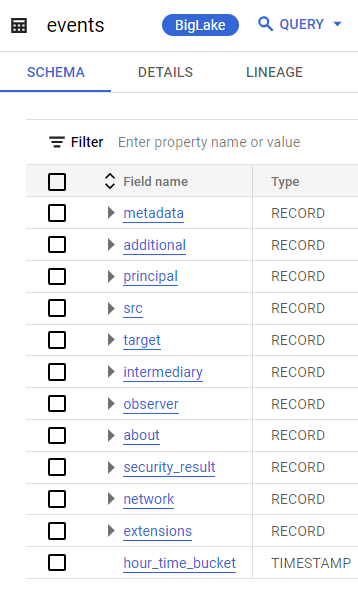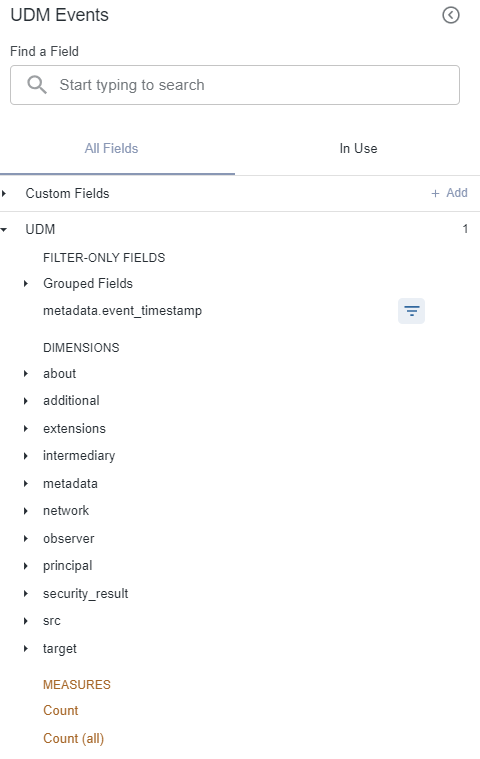Esquema de eventos do Google SecOps
No BigQuery, a tabela events armazena registros de eventos do UDM.
O campo hour_time_bucket identifica a partição como a hora do dia no campo UDM metadata.event_timestamp. Os valores no campo hour_time_bucket
são carimbos de data/hora de hora em hora que têm o formato: <YYYY-MM-DD HH:MM:SS UTC>. Confira alguns exemplos:
- 2022-05-20 00:00:00 UTC
- 2022-05-20 01:00:00 UTC
- 20/05/2022 02:00:00 UTC
- 20-05-2022 03:00:00 UTC
Por exemplo, o valor 2022-05-20 00:00:00 UTC rotula os dados com um event_timestamp entre 2022-05-20 00:00:00 UTC e 2022-05-20 00:59:59 UTC. Para mais informações, consulte Consultar tabelas particionadas.
O tempo que os dados levam para aparecer na tabela events depende
da diferença entre o momento em que o dispositivo registra o evento, o metadata.event_timestamp,
e o momento em que esse evento é transferido para o SIEM do Google Security Operations, o metadata.ingested_timestamp.
Confira a seguir o tempo que os dados levam para aparecer na tabela events depois de serem recebidos pelo Google Security Operations:
- Se a diferença for menor que duas horas, os dados vão aparecer aproximadamente duas horas após a transferência.
- Se a diferença for entre 2 e 24 horas, pode levar até 4 horas para os dados aparecerem após a transferência.
- Se a diferença for maior que 24 horas, pode levar até cinco dias para que os dados apareçam depois da ingestão.
O esquema da tabela events muda regularmente. Para conferir informações sobre a tabela,
incluindo o esquema atual, consulte as instruções do BigQuery para consultar informações da tabela.
Para acessar o esquema events, faça o seguinte:
- Abra o console Google Cloud e selecione o ID do projeto do Google SecOps que o representante do Google SecOps compartilhou com você.
Selecione BigQuery > BigQuery Studio > data lake > eventos.

Figura: tabela
eventsno BigQuery
Modelo de dados Events para painéis
Nos painéis incorporados do Google SecOps, você vai notar a estrutura de dados chamada Eventos do UDM.
Este é um modelo de dados do Looker criado para a tabela events no BigQuery.
A tabela inclui os campos de UDM mais usados. Ele não inclui todos os campos do UDM. Se houver campos de UDM ausentes que precisam ser incorporados a um painel personalizado, entre em contato com seu representante do Google SecOps.
Para acessar os campos nesta Análise detalhada, siga estas etapas:
- Na barra de navegação, clique em Painéis.
- Crie um painel (clique em Adicionar > Criar novo) ou edite um painel existente.
- Adicione um bloco.
- Selecione Visualização como o tipo, se solicitado.
- Na lista de tabelas, selecione Eventos do UDM.
Navegue pela lista de campos.

Figura: lista de campos no modelo de dados de eventos do Google SecOps
A seguir
- Confira uma descrição de cada campo da UDM na Lista de campos do Modelo de Dados Unificado.
- Para informações sobre como acessar e executar consultas no BigQuery, consulte Executar jobs de consulta interativa e em lote.
- Para saber como consultar tabelas particionadas, consulte Consultar tabelas particionadas.
- Para saber como conectar o Looker ao BigQuery, consulte a documentação do Looker sobre como se conectar ao BigQuery.
- Informações sobre como consultar tabelas particionadas.

